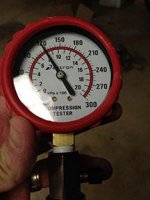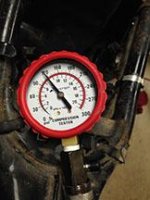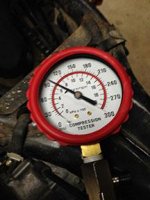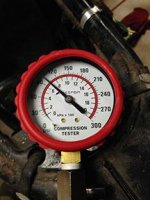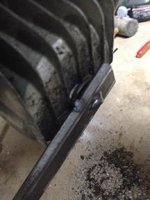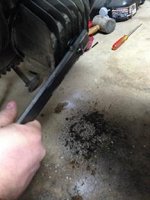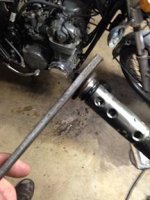We noticed you are blocking ads. DO THE TON only works with community supporters. Most are active members of the site with small businesses. Please consider disabling your ad blocking tool and checking out the businesses that help keep our site up and free.
You are using an out of date browser. It may not display this or other websites correctly.
You should upgrade or use an alternative browser.
You should upgrade or use an alternative browser.
Well now I have really done it...
- Thread starter Szeigler
- Start date
jsharpphoto
Coast to Coast
teazer's eagle eye spotted the "U.S. General" on the face.
Szeigler
Active Member
Ok so different compression gauge gives different results. the verdict is...
Cyl 1 = 120ish
Cyl 2 = 120ish
Cyl 3= 100ish
Cyl 4 = 100ish
Kinda thinking it is time to rebuild the carbs and find an exhaust add some gas and see if she will turn over. I have seen folks say that the cyls need to be within 10psi of each other, is that a hard and fast rule or just a suggestion?
Cyl 1 = 120ish
Cyl 2 = 120ish
Cyl 3= 100ish
Cyl 4 = 100ish
Kinda thinking it is time to rebuild the carbs and find an exhaust add some gas and see if she will turn over. I have seen folks say that the cyls need to be within 10psi of each other, is that a hard and fast rule or just a suggestion?
Attachments
Those numbers are still low. Bike will likely run, but if those numbers are accurate, its time for at least a hone and fresh rings.
The 3/4 numbers might suggest a headgasket leak between cylinders? I'm not the expert. Only way to know 100% is a leak-down test. The penultimate compression test You put compressed air into the cylinders and see how many PSI it holds, and where it's leaking out.
You put compressed air into the cylinders and see how many PSI it holds, and where it's leaking out.
If it leaks out of the exhaust port (while at TDC) your exhaust valve is leaking. If out the intake, the intake valve is leaking. If out the open dipstick port, it's getting past the rings. If out of the neighbor cylinder's open spark plug hole, you have a gasket leak between cylinders.
It will probably be difficult to get it running well, carbs sync'd etc. But you might get it there. Nice thing again about the CB550 is you can rebuild the engine in-frame, so keep on trucking. Get the bike sorted, and rebuild it if you have to with one of those kits.
If you're on a massive budget crunch, then taking the cylinders and pistons into a machine shop will help tell you if you can get away with just rings and a hone, which you can do yourself. You need someone to measure the pistons and cylinders to see if they're still in spec. If not, you're into a fresh bore which you'll need new oversize pistons for like in those kits.
The 3/4 numbers might suggest a headgasket leak between cylinders? I'm not the expert. Only way to know 100% is a leak-down test. The penultimate compression test
If it leaks out of the exhaust port (while at TDC) your exhaust valve is leaking. If out the intake, the intake valve is leaking. If out the open dipstick port, it's getting past the rings. If out of the neighbor cylinder's open spark plug hole, you have a gasket leak between cylinders.
It will probably be difficult to get it running well, carbs sync'd etc. But you might get it there. Nice thing again about the CB550 is you can rebuild the engine in-frame, so keep on trucking. Get the bike sorted, and rebuild it if you have to with one of those kits.
If you're on a massive budget crunch, then taking the cylinders and pistons into a machine shop will help tell you if you can get away with just rings and a hone, which you can do yourself. You need someone to measure the pistons and cylinders to see if they're still in spec. If not, you're into a fresh bore which you'll need new oversize pistons for like in those kits.
Technically a 4 stroke leakdown test involves 100psi air and a two gauge leakdown tester,. but all you really need is a compression tester hose and connect that to an air supply and put the bike in gear or have a wrench on the crank to stop the motor from spinning over.
Set one cylinder at close to TDC on the firing stroke and let the air in and listen for leaks. Repeat on the other 3 but make sure that the valves are closed.
Set one cylinder at close to TDC on the firing stroke and let the air in and listen for leaks. Repeat on the other 3 but make sure that the valves are closed.
Hoosier Daddy
Earache my eye...
...then your compression test numbers should be a lot higher.
jsharpphoto
Coast to Coast
Shouldn't the compression test be done on a warm engine?
Szeigler
Active Member
While I am waiting for a few parts I decided to go looking for some inspiration for where I am headed with this bike. Has anyone looked at this build or know anything about how they accomplished it. I like how minimal it is but I think they must have cut the fork down or something to get this stance.
http://silodrome.com/honda-cb550-cafe-racer/
http://silodrome.com/honda-cb550-cafe-racer/
Szeigler said:While I am waiting for a few parts I decided to go looking for some inspiration for where I am headed with this bike. Has anyone looked at this build or know anything about how they accomplished it. I like how minimal it is but I think they must have cut the fork down or something to get this stance.
http://silodrome.com/honda-cb550-cafe-racer/
They probably lowered the fork. You can do it internally by putting a spacer over the bottom pipe between the head of the bottom pipe and the rebound spring. Then you cut the fork spring to accommodate the space for the spacer. There are several posts about this on the forum, plus it's something I did to mine.
My build is half complete, so some of my info is from research. What I do know is the most noticeable difference in ride since I lowered it was the tightening up of the suspension when the fork spring got cut. I may cut more and add another spacer at the top of the spring. The more you cut the fork spring, the stiffer the ride. I raised my rear and lowered my front, so the rake is much more than stock. Through research, at least as I understand it (and I don't know if any of it will be noticeable), the new position should improve turning. It moves weight bias forward, which should improve braking. Lowering can take away your lean, but I thought mine had enough to give up.
Szeigler
Active Member
So one of the other rusty bits on this bike that I have been trying to reason out how to remove is the oil filter cover bolt. Mine came to me very rusty and when I attempted to use a socket on it it promptly rounded off which kinda blew my mind. After thinking on it I decided to take a piece of 1/8" steel strap about 7 inches long and drill a hole in one end that was big enough to lay over the top of the now fully rounded bolt head. I held that in place and tack welded it with the trusty Mig welder and then proceeded to weld up the hole. This permanently attached the bolt head to the strap. Once I finished up the weld I proceeded to tap the strap with a ball peen hammer lightly, and then put pressure with my hand until the bolt broke free. This is an old timer's trick that I had seen in use and chatted with some old timers about but had not until today used myself. Pics for your entertainment.
Attachments
Hoosier Daddy
Earache my eye...
Congrats on getting it out, some can be a real PITA!
Bozz
Coast to Coast
yes, but it takes a hell of a leg.
CHeck your ignition timing carefully, with a full battery you should be able to check for spark with a kick over, but it helps to have a friend do the kicking so you can watch carefully.
If you have spark and it's timed correctly, sometimes starting fluid can help the process if the fuel isn't flowing well.
IT's easy to flood on the kicker though, so be careful and check your plugs aren't wet.
Best of luck!
CHeck your ignition timing carefully, with a full battery you should be able to check for spark with a kick over, but it helps to have a friend do the kicking so you can watch carefully.
If you have spark and it's timed correctly, sometimes starting fluid can help the process if the fuel isn't flowing well.
IT's easy to flood on the kicker though, so be careful and check your plugs aren't wet.
Best of luck!


